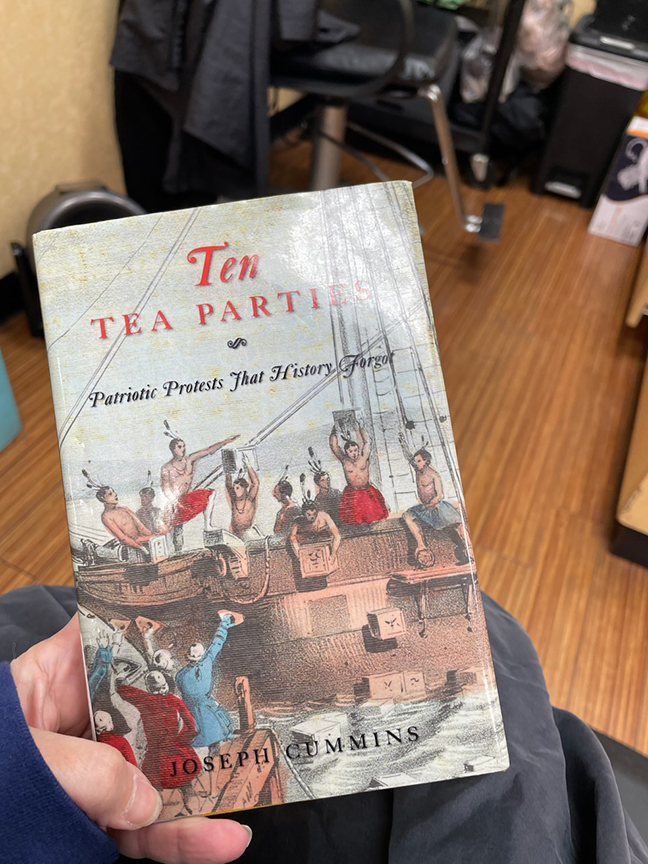
Guest Column
It all started when 15-year-old John Robinson was walking along the shore in Dorchester Heights, just outside Boston in the early morning hours of December 17, 1773.
Although the water was thick with tea leaves, he managed to spot a wooden chest partially buried in the sand. He was well aware of what had happened the night before when over 90,000 pounds of East India Company tea was dumped into Boston Harbor in defiance of British authority. Regardless of the consequences, young John rescued the chest, a dark green wooden crate measuring approximately 10” high, 13” wide and 12” deep. The treasured box remained in his family for the next 239 years before being placed on display in the Boston Tea Party Ships and Museum in Boston. It is one of only two known surviving chests from the Boston Tea Party.
The Robinson half tea chest has an interesting history. Robinson kept the crate from 1773 until his death about 1819. John’s wife, Nancy, remarried soon after his death and moved to Gouverneur, New York. She kept the box until 1843 when she gifted it to Solomon Shaffstall as a “thank you” for helping her son and his wife when they were ill.
Shaffstall, residing in Door County, Wisconsin at the time, was a relative of the Robinsons through his wife, Zilpa Marsh. Always a history buff, he had often discussed the historical significance of the box with Nancy.
Shaffstall kept the box 29 years before giving it to his 8-year-old granddaughter, Mary Lurana, whom he and his wife were raising following the death of her parents. She used it to hold her dolls and later her cat claimed it and had her kittens there. Mary Lurana held onto the box for 77 years and during that time had a notarized affidavit written which she signed along with a letter from her grandfather authenticating the piece and tracing its history. The family moved from time to time but always kept the treasured box with them. Eventually, they moved to Knoxville, Tennessee, where in 1896 Mary Lurana married Isaiah Ford. They remained there until 1910 when they relocated to Texas. After Mary Lurana’s death in 1949, the box passed to her daughter, Helen, who held it until her passing in 1961. Helen was instrumental in authenticating the history of the piece. It took 10 years of research to trace her family’s unbroken chain of ownership converting oral history to documented history. Her brother William Ford inherited the box upon her death.
It was while the box was in his possession that the Smithsonian Institute contacted him. The renowned institution had learned of the chest, tracked it down and asked that it be displayed in one of their museum exhibits as part of the multi-year celebration of America’s Bicentennial. The family agreed and the treasured box was displayed where it was viewed by millions.
Unfortunately, William died while the box was at the Smithsonian and it was then given to his daughter, Bettie Ford Goodman.
She kept the box from 1976-2004. While in her possession, the family proudly showed it to friends and the children used it for school projects but Bettie wanted it to be seen by the public. It was her son Andre who learned of the planned museum in Boston to commemorate the Boston Tea party. After extensive authentication, the museum purchased the box and it is now the centerpiece of their exhibit. For generations it was treasured and lovingly preserved along with its history. The box has traveled from Boston to New York, to Wisconsin, to parts unknown, to Tennessee, to Texas to Washington, D.C. back to Texas and finally returned to Boston where it began. We aren’t sure exactly how many years the box remained in Tennessee but it was for more than 14 years.
This adds a surprising link of this important event in the history of the founding of our nation to the Volunteer State.
On December 16, we will be celebrating the 250th Anniversary of the Boston Tea Party. To protest Britain’s passing of the Tea Act which was considered “taxation without representation” and the monopoly given to the British East India Company, American colonists, loosely dressed as Indians, marched to Griffin’s wharf, where they boarded three ships, the Dartmouth, Eleanor and Beaver, and tossed the chests of tea into Boston Harbor. This act of defiance was a rallying point for Americans in their fight for independence.
More information and photos may be found at https://www.bostonteapartyship.com/partners/a-box-worth-keeping



